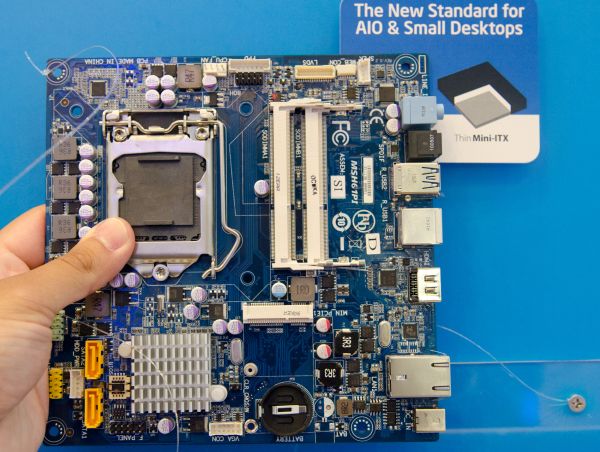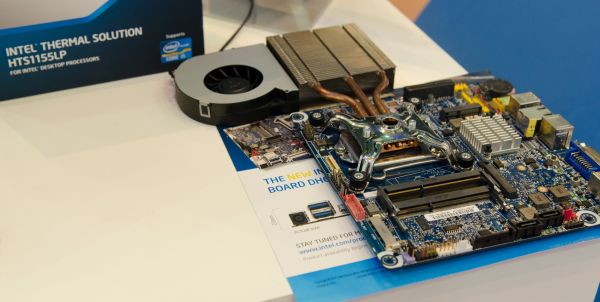More on Intel's Thin Mini-ITX Standard
by Anand Lal Shimpi on June 1, 2011 12:42 AM EST- Posted in
- Trade Shows
- Intel
- Motherboards
- thin mini ITX
- Computex 2011
I stopped by Intel's booth at Computex to grab a few shots of the small but potent Thin Mini-ITX ecosystem. If you read our coverage yesterday you'll remember that Thin Mini-ITX is just a low profile Mini-ITX standard designed for affordable (or potentially DIY) all-in-one PCs.
Intel had a number of Sandy Bridge motherboards on display that conform to the Thin Mini-ITX standard. Most of the boards use Intel's H61 chipset:
The cooling system is also standardized. Below is an example of the cooling solution Intel will be selling in Q4 of this year:
Intel also had a number of all-in-one cases available. While most weren't all that elegant looking, this model from Loop looked very Apple-like:
There were a number of DC power adapters on display, ranging from 150W to 180W. The power connector is also a standard.
Going forward as the majority of desktops move to even lower TDPs, these DIY all-in-one systems may end up becoming more popular. One major issue I see right away is the lack of support for discrete graphics. Go far enough into the future and perhaps that won't be so important, but today it's not fun driving a high resolution panel off of SNB integrated graphics. I do hope that as Intel pushes for this standard it doesn't forget that discrete GPUs are still quite necessary for many users in 2011. Maybe we'll eventually get that upgradable 27-inch iMac that I was asking for recently.













18 Comments
View All Comments
Klinky1984 - Wednesday, June 1, 2011 - link
I am not sure there is much benefit from an "all-in-one" setups. If it's that low profile it could easily fit in a thin little platform that the monitor could stand on. I am just wondering how many LCD manufacturers are going to get on board with this & how much of a premium it will be to get an "all-in-one" ready LCD. There is probably a niche for it, but it'll probably be pricier, ruining one of the benefits of DIY.CSMR - Saturday, June 4, 2011 - link
There is always some noise, even in fanless setups. Behind the monitor, less noise is heard by the user and there is better damping.Gozza - Sunday, June 5, 2011 - link
This is just plain silly design. You have these issues :1) the need for an internal header for monitor connection - no standard.
2) cooling - either the cooler grows sideways, or upwards. Either way it takes space.
3) 24 pin ATX power connector is as high as the old back panel. What`s the point of making the back panel smaller if the internals are still taller than it. This suggests the need for a new power/ATX connector.
4) the PCI-E slot - what`s the point of the PCI slot when there is NOTHING you can put in it (there`s no cards only 25 mm tall !!)
5) LACK of features. The current crop mini-ITX boards are amazing - they have USB 3.0, wireless, DVI-VGA-HDMI, absolutely everything you need. This boards is a step back in time to 2005.
6) PSU - this board will require an external power pack. Geez, it's not like I already have too many power bricks all over the place, another one wil be great. /SARCASM
7) This board is only 19mm thinner. All these problems for 19mm ?? CRAZY
magneticfield - Wednesday, June 22, 2011 - link
I'm late on this, but :1) There is a well-established standard for an internal monitor connection. It's actually a connection that goes directly to the LCD panel, just like in laptops, it's called LVDS.
You can see the connector at the top of the first image.
2) cooler can go sideways, as there is enough room (mini-ITX is a lot smaller than a 17-24" display)
3) the article reads "The power connector is also a standard." ; there is an external power connector, it's powered by a brick
4) you don't need big components in a all-in-one. if you need dual slot graphics cards, you'll get a midi tower and be done
5) there will be different set of features on different boards, there are no restrictions on this
6) that's true
7) lol
Cullinaire - Wednesday, June 1, 2011 - link
A stock Intel cooler that doesn't use push-pins?You don't say.
softdrinkviking - Wednesday, June 1, 2011 - link
i don't think that's stock. the aftermarket box is in the background. :(Guthy - Wednesday, June 1, 2011 - link
Well if they add a 90 degree pci-e 16 slot to the RH side of the board then they'ed have a buyer here straight away.I'm currently halfway through a build that involves hacking a 2U Server Chassis to pieces to give me suitable case to build on the back of my 26" monitor. At the mo I've using a MATX board with a move soon to ITX, but this would be ideal
ASHERMAN - Wednesday, July 13, 2011 - link
This comment is a little late, but I was curious how your hacked 26" all-in-one PC was coming along. I work for NextComputing and we've been looking at coming out with a high-end, upgradeale All-In-One, either something with ATX or Micro-ATX, a Thin Mini-ITX design, or both. What's your take on this sort of thing and if there would be other guys besides you that might want something like this? Hit me up at asherman [at] nextcomputing [dot] com if you want to talk more about it. I'm intrigued...MonkeyPaw - Wednesday, June 1, 2011 - link
I don't getbthe cooling solution. It takes a tiny board and increases the footprint in both length and width. I guess it soils bending on the back of a monitor, but I was thinking they'd want to.sell this to HTPC crowds as well. Maybe there's more than one cooling option?Doltmoopsie - Wednesday, June 1, 2011 - link
Now that we have seen the cooling solution, we know that Intel has no intention of having discrete graphics on this platform.This platform could have housed a dual-slot graphics card if it was using a 90 degree adapter, like in server cases. The CPU cooling fan and heat-sink are off the edge of the board in the space that would house the graphics card.
If they had wanted to leave room for a card along the same plane as the motherboard, they would have made the CPU cooling fan sit off the back of the board (away from the I/O plate), facing up or down.